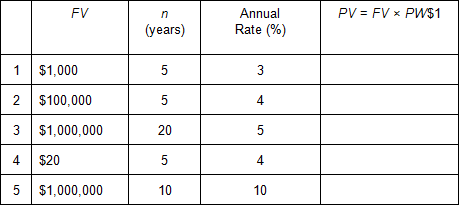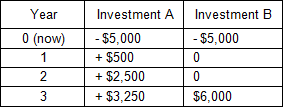Lesson 3: Present Worth of $1
Check Your Knowledge
In order to solve the following problems you will need to refer to AH 505 to look up the factors in the compound interest tables. Before you start, please print the problems using the "Print Questions" button below so you can work through the problems on your own. After you work through the problem, the solution can be viewed by clicking on the blue plus sign immediately following the question. Additionally, when you have completed all the problems, you may print all of the solutions using the "Print Questions with Answers" button below.
Problem 1
Calculate the present value (PV) of each future value (FV) listed below using the present worth of $1 (PW$1) factors in AH 505:

Solution 

Solution:
To solve, calculate the present value of each future value amount by multiplying the amount by the present worth of $1 factor found in the AH 505 annual compound interest tables for the given interest rate and term.
PV = FV × PW$1
PV = $1,000 × 0.862609 (AH 505, page 21, column 4)
PV = $862.61
PV = FV × PW$1
PV = $100,000 × 0.821927 (AH 505, page 25, column 4)
PV = $82,192.70
PV = FV × PW$1
PV = $1,000,000 × 0.376889 (AH 505, page 29, column 4)
PV = $376,889.00
PV = FV × PW$1
PV = $20 × 0.821927 (AH 505, page 25, column 4)
PV = $16.44
PV = FV × PW$1
PV = $1,000,000 × 0.385543 (AH 505, page 49, column 4)
PV = $385,543.00
Problem 2
Assume that you would like to have $500,000 saved by the time you reach 50 and that you are 30 years old today.
If you can earn an annual interest rate of 8%, how much should you invest today to reach your goal?
Solution 

Solution:
To solve, calculate the present value of the amount you want to have at the end of the term using the present worth of $1 factors in the AH 505 annual compound interest tables with an annual rate of 8%. The term is 20 years (age 50 less your current age of 30).
PV = FV × PW$1 (8%, 20 yrs, annual)
PV = $500,000 × 0.214548 (AH 505, page 41, column 4)
PV = $107,274.00
Problem 3
You would like to be able to withdraw $10,000 at the end of 5 years, and another $10,000 at the end of 10 years.
If you can earn an annual interest rate of 5% on a deposit, how much should you deposit today?
Solution 

Solution:
To solve, calculate the present values of the two planned withdrawals using the present worth of $1 factors in AH 505 for each of the two terms at 5% annual compounding; and then add the two results.
PV First Withdrawal
PV = FV × PW$1 (5%, 5 yrs, annual)
PV = $10,000 × 0.783526 (AH 505, page 29, column 4)
PV = $7,835.26
PV Second Withdrawal
PV = FV × PW$1 (5%, 10 yrs, annual)
PV = $10,000 × 0.613913 (AH 505, page 29, column 4)
PV = $6,139.13
You would need to deposit $7,835.26 + $6,139.13 = $13,974.39
Problem 4
Mr. Smith wants to borrow money from you to finance his new business.
He promises to repay you in two installments: a payment of $5,000 two years from today, and a second payment of $10,000 four years from today.
If the annual interest rate is 10%, how much would you lend Mr. Smith today?
Solution 

Solution:
To solve, calculate the present value of each installment using the Present Worth of $1 factors in the AH 505 annual compound interest tables for each term (2 years and 4 years) at an annual interest rate of 10% and add them together.
First Installment
PV = FV × PW$1 (10%, 2 yrs, annual)
PV = $5,000 × 0.826446 (AH 505, page 49, column 4)
PV = $4,132.23
Second Installment
PV = FV × PW$1 (10%, 4 yrs, annual)
PV = $10,000 × 0.683013 (AH 505, page 49, column 4)
PV = $6,830.13
Total present value = $4,132.23 + $6,830.13 = $10,962.36
Problem 5
Two investments A and B have the following annual cash flows (CF). Which investment is preferred, given an annual interest rate of 5%?
(The initial cash flows are negative, indicating outflows, and the subsequent cash flows are positive, indicating inflows.
All inflows occur at the end of the year.)

Solution 

Solution:
To solve, calculate the present value of the cash flow at the end of each year using the present worth of $1 factors in the AH 505 annual compound interest tables with an annual rate of 5% and then add all of the present values. Compare the sum of each investment to determine which has the higher present value.

The present value of the cash flows from Investment A, $551, is higher than those from Investment B, $183, so Investment A is preferred.
Problem 6
Assuming all cash flows (CF) occur at the end of each year, determine the present values of each of the following two series of cash flows:

Solution 

Solution:
To solve, calculate the present value of the cash flow at the end of each year using the present worth of $1 factors in the AH 505 annual compound interest tables with an annual rate of 5% for series 1 cash flows and 4% for series 2; and then add the present value of each cash flow in the series. The sum is the present value of the series.
PV of Series 1 (AH 505, page 29, column 4)

PV of Series 2 (AH 505, page 25, column 4)



